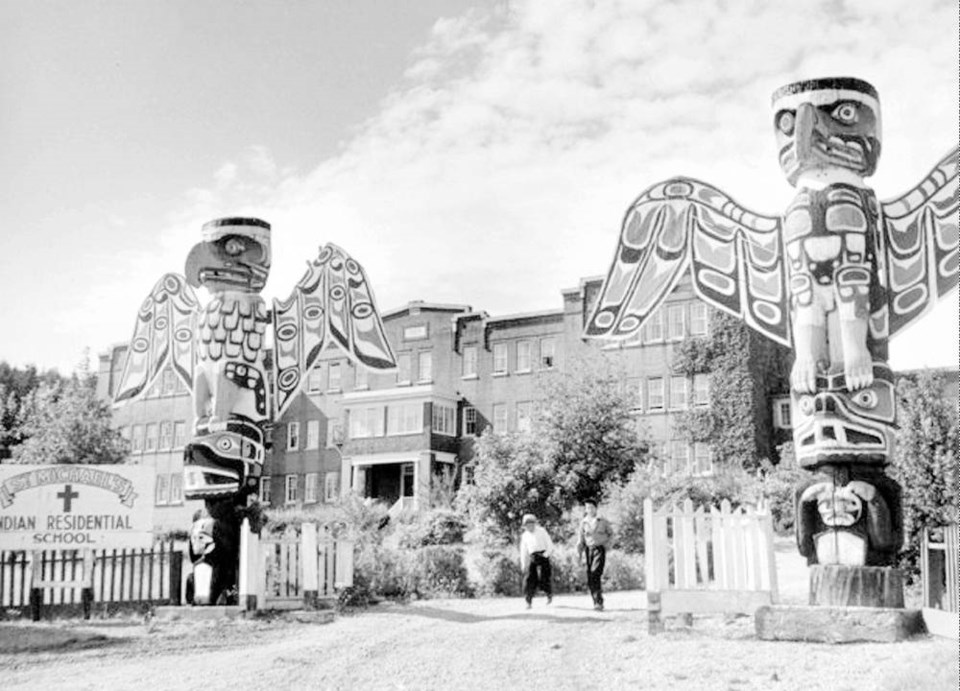Two more First Nations on Vancouver Island are investigating whether their lands hold any unmarked graves of children who attended now-closed residential schools.
The ‘Namgis First Nation, based at Alert Bay on Cormorant Island on the east coast of Vancouver Island, and Ahousaht First Nation, based on Flores Island off the west coast, are each preparing projects.
Ahousaht is receiving $75,000 to cover the cost of ground-penetrating radar from a GoFundMe campaign organized by a trio of First Nation members to help communities carry out the work.
The campaign, which raised $153,000, was launched after what are believed to be 215 grave sites were located on the site of the former Kamloops residential school.
Funds will be presented Saturday at 11 a.m. outside Mungo Martin House at the corner of Belleville and Douglas streets in Victoria.
This is the first funding to be distributed — talks are underway with other First Nations, said Steve Sxwithul’txw, who launched the campaign with Michele Mundy and Tom LaFortune.
“I’m thrilled that we are able to assist the Ahousaht people in this way, but sad about the circumstances that surround this initiative,” Sxwithul’txw said.
The Penelakut Band recently revealed that work with ground-penetrating radar, started in 2014, has discovered what are believed to be more than 160 unmarked and undocumented graves associated with the former Kuper Island residential school. Kuper Island, off Chemainus, was renamed Penelakut Island.
Ahousaht Chief Greg Louie is hoping radar work will be completed this summer. A consultant co-ordinator will be hired.
Mental-health workers,, clinical counsellors, and band spiritual workers will be on hand, and cultural protocol will be observed, Louie said. “We know that there will be people who will be triggered emotionally.”
The Ahousaht residential school operated from 1904 to 1940 and served students from Ahousaht and other First Nations. After it was torn down, the lands were sold to a private owner for a sawmill and are now back in the hands of the First Nation. Work has begun to clear the site, where a $2-million wellness centre will go up, Louie said.
The Christie residential school on Meares Island ran from 1900 to 1983 and was later destroyed by fires. Today, the Ahousaht First Nation operates a campground and has trails on the property.
Louie, who was a student at the Christie school from age six to 10, said he was hit by nuns while there. His late sister attended as well and was abused there, he said.
The Christie school took local youngsters as well as others from areas such as Saanich, Cowichan, Sechelt, Squamish and Songhees, according to information from the Indian Residential School and Dialogue Centre at the University of British Columbia.
In Alert Bay, the former site of the St. Michael’s Indian Residential School, an imposing building that looked out to the water, remains undeveloped.
Once the largest residential school run by the Anglican Church, the school was demolished in a ceremony in 2015 in front of a crowd including former students. The school operated from 1894 to 1974, at Alert Bay.
“Recently uncovered unmarked burial grounds of First Nations children at the sites of former residential schools in B.C. and Saskatchewan have shaken First Nations throughout Canada,” the ‘Namgis Nation said in a statement.
“The discoveries have shown that there is still much to be brought to light from the dark years of the residential school practices of mistreatment and abuse that lasted for decades.”
Chief Don Svanvik said the work has to be handled carefully and with sensitivity because it brings up so many emotions and dark memories. It is impossible to say how long the work will take, he said. “It’s a really big job.”
The upcoming project will include a search for documents that could point to the existence of unmarked graves of First Nation children.
As with Ahousaht, former students will be interviewed and mental-health and other supports will be offered.
The project will identify qualified contractors to survey the area and propose further follow-up action depending on the findings, the band’s statement said.
Children from many nations attended the St. Michael’s Indian Residential School, including Campbell River, Bella Bella, Haida Gwaii, Kitwancool and Kitwanga, according to the Indian Residential School and Dialogue Centre.
The centre said that in 1947, two dozen children ran away from the school, and the subsequent investigation into conditions led to the resignation of the principal and vice-principal.
By 1969, when the federal government assumed administration of the school, all residents were attending local schools, and the residence closed in 1974, the centre said, citing the National Centre for Truth and Reconciliation.



